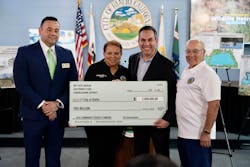Lake Rialto Habitat Project receives $2 million in federal funds
The City of Rialto has received $2 million in federal funding to support its Lake Rialto habitat project. California Congressman Pete Aguilar, D-33rd District, secured the funds for the program. The Congressman said, “Ensuring our residents can enjoy safe and clean open spaces for outdoor recreation is necessary to create a healthier, more sustainable community.”
This brings total funding for the $8 million project to more than $3 million, thanks to earlier funding from the state.
“This funding I helped secure will help construct Lake Rialto, 10 acres of lake, wetlands and trails, that will protect vulnerable species and play a vital role in the environmental success of the Santa Ana River Habitat Conservation Plan,” Aguilar said.
Formally called the Lake Rialto Habitat Management Community Open Space, the Lake Rialto project's environmental benefits include the creation of a lake, wetlands and wildlife habitats on city-owned property adjacent to the City of Rialto Water Treatment Plant, which will provide recycled water for the lake itself, which then flows into the environmentally critical Rialto Channel.
The treatment plant produces roughly 7 million gallons of water per day. Of that total, 3.8 million gallons flow into the Santa Ana River via the concrete-lined channel.
“The project design is now 90% complete, and we hope to break ground this coming fall,” Rialto Mayor Deborah Robertson said.
The project will transform what is currently a weed-strewn hole in the ground into a lake and wetland habitat teeming with California native flora, fauna and aquatic species. Lake Rialto's creation will serve to enhance the nearby Upper Santa Ana River Wash Habitat Conservation Plan.
That plan took two decades to “...develop an integrated approach to permit and mitigate construction and maintenance activities with the Wash area, including water conservation, wells and water infrastructure, aggregate mining, transportation, flood control, agriculture, trails, and habitat enhancement.”
The Lake Rialto project lies a few miles due west of the Wash Plan area but is close enough to complement that project. Its connection to the Santa Ana River via the Rialto Channel means that its success will be a welcome assistance for the Wash area.
Among the plants and animals to be helped in the Wash Plan are the Slender-horned spineflower, Santa Ana River wooly star, Cactus wren, Coastal California gnatcatcher and the San Bernardino kangaroo rat. Years ago, old-timers can recall when the area was known for its California Quail population and city staff are hopeful that they will return.
Mayor Robertson noted that when she first saw the site for the first time, “I wondered what this big, deep hole was. I found out from people at the water treatment plant that it had once been a kind of holding retention basin for water treated before upgrades to the facility made the basin no longer needed. That was what planted the seed of an idea in my head that perhaps one day, the city could do something to transform that eyesore into something of value to the people of Rialto.”
With the help of outside consultants, the city has executed a nearly complete blueprint and secured both state and federal funds to execute the plan.
Lake Rialto seeks to create a smaller-scale version of the San Joaquin Marsh Reserve model at the University of California, Irvine campus in Orange County. That project opened in 1970 and comprises 200 acres of environmentally diverse habitat for a host of aquatic and ground-dwelling fauna, as well as a popular home for a large variety of wildfowl and California native bird species.
Lake Rialto’s environmental benefits will include helping to preserve the populations of two endangered native fish, the Santa Ana sucker and the Arroyo chub, which have been threatened by the loss of riverine habitat and a succession of drought years.
At present, the Santa Ana sucker and Arroyo chub swim from the Santa Ana River up the Rialto Channel, but during hotter days, the water can be too warm for the fish. Because of the depth of the lake, much-needed cooler water can be taken from the bottom of the lake and discharged into the Rialto Channel, providing potentially significant environmental benefits to these critical species. The city of Rialto has worked diligently to explore and maximize all the environmental benefits of this project.
The lake will also provide a habitat for seasonal wildfowl who migrate to and from Mexico and Central America along the Pacific Flyway, providing abundant birdwatching opportunities for the community. Migratory bird species known to pass through the two-county (San Bernardino and Riverside) Inland Empire include several species of geese, ducks and a variety of shore birds.
Future plans include bringing K-12 schoolchildren to the lake to observe migratory and native bird species, both during seasonal migrations and all year around.
The City of Rialto has also entered into a 50-year agreement with Inland Empire Utilities Agency (IEUA), a wholesale water distributor. Per the agreement, the city will provide excess recycled water to IEUA from May through October to help it meet increased demand during the warmer months.
IEUA will provide $45 million to build a pipeline and a pump station, along with a connector from the Rialto treatment facility to the agency's distribution system.
“Rialto residents can look forward to enjoying the lake's open spaces, hiking trails and environmental education programs,” Mayor Robertson said. “Special programs for children will enable them to get a taste of the great outdoors right in their own city.”
“We're so very pleased and honored that Congressman Aguilar has supported this leading-edge project to create an infrastructure that will serve as an environmentally sensitive and attractive recreational facility and wildlife habitat.”
Mayor Robertson added: “Support for this model of an urban water stewardship project is something all of our elected policymakers should be advocating. This needs to be at the forefront of their priorities.”
The City of Rialto has grown a lot in recent years with its ongoing development projects. Now, Lake Rialto adds to an impressive list of commercial and residential projects, a different kind of addition to the city's assets that demonstrates that it “walks the talk” when it comes to planning environmentally sensitive development.
About the Author
Greg Zerovnik
Dr. Greg Zerovnik is a copywriter and public relations specialist with Dameron Communications. His doctoral research in the field of media psychology infuses his writing with an appreciation of the broad range of human and media interactions and how they influence each other. His work over the years has included clients that are nonprofit, for-profit and governmental institutions. His interest in water-related issues stems from a childhood fascination with freshwater fishing in his native Ohio and his more recent saltwater fishing in Southern California.




